
They Drew As They Pleased: The Hidden Art of Disney’s Golden Age (The 1930s)
Hardcover
By Didier Ghez
Foreword by Pete Docter
Publisher: Chronicle Books
Release Date: September 8, 2015
The first volume in a series that examines the craftsmanship of Disney artists responsible for the studio’s most recognizable and beloved products, They Drew As They Pleased: The Hidden Art of Disney’s Golden Age exhibits artwork catalogued and concealed. Until now. Released last year to much fanfare, the Didier Ghez book would nicely accompany any collection of Disney titles. It’s a perfect introduction to the painstakingly detailed works by four relatively unknown Disney artists for both the Disney nerd and the casual fan.
The choice to center on artists who lack the familiarity of a Mary Blair or the like is a purely intentional choice by Ghez, who notates in the preface that other scholars have routinely referenced their creations. I respect Ghez’s decision, and paying attention to only a handful of artists allows for a sense of depth, not breadth. His unyielding desire to capture art that has not been surfaced for decades, if at all, comes through every meticulous page. Though he provides a bit of context on the process of uncovering the lost drawings and sketches here and there, what you find is a passion project that pays honor to amazing animators. Around six to 12 pages outlining each artist’s style and backstory are offered before a demonstration of the art. And what superb art there is!
First up is Albert Hurter, a Swiss-born American immigrant who served as a Disney concept artist during the studio’s formative years, responsible for a variety of Disney characters, such as Pete (Mickey’s primary enemy from the older years). Hurter’s eccentricities came out in his pieces, which draw from his decades of life experiences and unusual manner of looking at the world. From developing anthropomorphic beings to lending thoughts on the design of scenes, Hurter was a storyteller first and foremost. He lent that raconteur spirit to his work and to his colleagues, who he introduced to legendary illustrators.
Ghez’s ability to offer a rich and storied biography of an individual’s life in a mere handful of pages, complemented by the art as the feature presentation, is something to appreciate. Here we have more than an art book, but rather a historical treasure. Gehz aims to share Hurter’s story, like those of his three contemporaries, through the anecdotes of those who knew the artist best. Footnotes are abundant, serving as a valuable resource guide for future scholars. The art in Hurter’s section varies as much from fantastical flowers to musically inclined reptiles. His drawings of Jiminy Cricket, one of my favorite Disney characters, are mesmerizing, as the little guy was initially envisioned as more of an animal than the conscious insect we all grew to love in Pinnochio.

Next up is Ferdinand Horvath, a Hungarian-born POW who persevered in life and translated his gift for animation to the Walt Disney Studios. They Drew As They Pleased includes a touching letter he wrote to Walt himself, giving his case for employment. Horvath’s earliest days of experimenting with various ideas and concepts are chronicled, allowing the reader to glimpse into his initial trials. The Great Depression’s impact on animators’ lives offers additional context to the difficulties of working in animation during such an uncertain period. Horvath’s quick departure from Disney prompted a stint at Warner Brothers, punctuated by a lawsuit he lodged against the studio, and an eventual return to the Mouse House. Horvath’s wealth of work was evident in a number of Disney shorts – the art illustrated after the biographical section – and his tricky relationship with employer Walt Disney is given much attention. Among the most extensively covered art is from the unproduced, nautical-themed Mickey’s Sea Monster, complete with wacky renderings of a sea serpent. The settings he created for Snow White and the Seven Dwarfs are especially rich in visual appeal.

Gustaf Tenggren, meanwhile, entered the Disney studio in 1936, later than his contemporaries featured in They Drew As They Pleased. Tenggren devoting countless years toward perfecting his craft paid off in spades as an artist for magazines and children’s books. His personal demons and vices, however, sometimes compromised his relationships. I appreciate how Ghez’s tellings of these artists’ stories give a complete picture to their lives and not only highlights the mastery of their life’s work. What an impressive volume of art and quality Tenggren produced. From Snow White and the Seven Dwarfs to Pinnochio and many more, Tenggren’s gift in developing layouts was easily recognized by the studio. We see many of these examples in They Drew As They Pleased. Much like Horvath, though, Tenggren had tenuous interactions with key folks at the studio. His departure after only three years may make it seem like his contributions to Disney were minimal, but the amount of gorgeous content he contributed in that period is offered much adoration here. Most notable is the Academy Award-winning Silly Symphonies short The Old Mill, in which Tenggren had a major role.

Finally, Ghez spotlights the only female animator with a chapter in this book: the incomparable Bianca Majolie. At a time when female animators were limited to less glamorous animation positions in the studio, Majolie had broken the glass ceiling. Once a high school classmate of Walt, Majolie reached out to her old friend with a goal to work at the studio. Though paid less than her male counterparts, Majolie offered important contributions in the story department and paved the way for other women hired alongside her. Majolie’s work for Fantasia is shown in her dream-like ideas for the Nutcracker Suite sequence. Additionally, the concepts she provided for Tinker Bell in Peter Pan and Cinderella would serve as inspiration for successors in the studio, who relied on those drawings when crafting those films many years after her departure.

What Ghez does best, in addition to masterfully compiling and arranging lovely artwork, is offering suitable commentary. It’s neither overwhelming nor absent. He strikes just the right amount of information accompanying the art to lend heightened interest, and the notes on each of the artists’ backgrounds increase the desire for seeing entire books on the featured subjects. Artwork from both Disney’s short subjects, like Silly Symphonies and full-fledged animated films, feel balanced. Needless to say this is a must-own book for those who want to have rare Disney art readily accessible. It’s the start of a superior series of books that shed a light on artists we may not have heard of before, but will now never forget.
Grade: A
This is Brett Nachman, signing off. Follow me on Twitter for alerts of new editions of Disney In Depth, released on the first and third Thursdays of each month on Geeks of Doom.












No Comments »
No comments yet.
RSS feed for comments on this post. TrackBack URL
Leave a comment